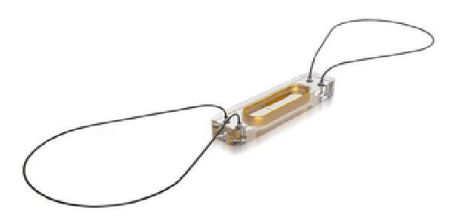A new wireless monitoring system that is implanted in the pulmonary artery can help keep patients with severe heart failure out of the hospital, according to a recent study. The CardioMEMS HF System from St. Jude Medical Inc. (St. Paul, MN, USA) is the only heart failure monitoring system approved by the Food and Drug Administration (FDA).
The monitoring system features a paper clip-sized sensor that is implanted in the pulmonary artery (PA) — the blood vessel that moves blood from the heart to the lungs — to measure PA pressure and heart rate. Increased PA pressure along with weight and blood pressure changes are signs of worsening heart failure. The system allows patients to transmit daily sensor readings directly to their doctor or nurse through a bedside electronics unit. The timely transmission of information allows for personalised and proactive management of the patient's condition.
The study involving patients with Class III heart failure found that the CardioMEMS HF System decreased heart failure hospital admissions by 28 percent six months after the device was implanted and more than 37 percent at 15 months. Class III heart failure is defined by the American Heart Association (AHA) as cardiac disease resulting in marked limitation of physical activity. These patients are comfortable at rest. They may experience palpitation, fatigue, dyspnea or anginal pain after engaging in less than ordinary physical activities. Nearly 1.5 million Americans live with Class III heart failure.
“The key to keeping heart failure patients out of the hospital has been to find an accurate measure of a marker that picks up fluid buildup in the body and I believe this system does that effectively,” said Dr. Arvind Bhimiraj, a cardiologist at the Houston Methodist DeBakey Heart & Vascular Center. Many studies have shown that there is at least a 15-day gap between the time of fluid accumulation and the patient experiencing symptoms, according to Dr. Bhimiraj. "If we can get to patients early, we can significantly lessen the chance of hospitalisation.”
Houston Methodist Hospital is the first institution in Houston (TX, USA) to offer the PA sensor to heart failure patients. The PA sensor is no bigger than the size of a dime with two thin loops at each end. It also does not require any batteries or wires. “This implant is designed to last a lifetime and the patient doesn’t have to worry about changing out batteries,” Bhimiraj said. “I truly believe it will help us give patients a better quality of life and significantly cut down on hospital admissions and readmissions.”
Heart failure occurs when the heart is unable to pump enough blood to meet the body’s demands. More than five million Americans live with heart failure and nearly 600,000 new cases are diagnosed each year, according to the Centers for Disease Control and Prevention. The estimated cost of heart failure in the US in 2012 was $31 billion and that figure is expected to double by 2030.
Source: Newswise.com
Image Credit: St. Jude Medical Inc.
The monitoring system features a paper clip-sized sensor that is implanted in the pulmonary artery (PA) — the blood vessel that moves blood from the heart to the lungs — to measure PA pressure and heart rate. Increased PA pressure along with weight and blood pressure changes are signs of worsening heart failure. The system allows patients to transmit daily sensor readings directly to their doctor or nurse through a bedside electronics unit. The timely transmission of information allows for personalised and proactive management of the patient's condition.
The study involving patients with Class III heart failure found that the CardioMEMS HF System decreased heart failure hospital admissions by 28 percent six months after the device was implanted and more than 37 percent at 15 months. Class III heart failure is defined by the American Heart Association (AHA) as cardiac disease resulting in marked limitation of physical activity. These patients are comfortable at rest. They may experience palpitation, fatigue, dyspnea or anginal pain after engaging in less than ordinary physical activities. Nearly 1.5 million Americans live with Class III heart failure.
“The key to keeping heart failure patients out of the hospital has been to find an accurate measure of a marker that picks up fluid buildup in the body and I believe this system does that effectively,” said Dr. Arvind Bhimiraj, a cardiologist at the Houston Methodist DeBakey Heart & Vascular Center. Many studies have shown that there is at least a 15-day gap between the time of fluid accumulation and the patient experiencing symptoms, according to Dr. Bhimiraj. "If we can get to patients early, we can significantly lessen the chance of hospitalisation.”
Houston Methodist Hospital is the first institution in Houston (TX, USA) to offer the PA sensor to heart failure patients. The PA sensor is no bigger than the size of a dime with two thin loops at each end. It also does not require any batteries or wires. “This implant is designed to last a lifetime and the patient doesn’t have to worry about changing out batteries,” Bhimiraj said. “I truly believe it will help us give patients a better quality of life and significantly cut down on hospital admissions and readmissions.”
Heart failure occurs when the heart is unable to pump enough blood to meet the body’s demands. More than five million Americans live with heart failure and nearly 600,000 new cases are diagnosed each year, according to the Centers for Disease Control and Prevention. The estimated cost of heart failure in the US in 2012 was $31 billion and that figure is expected to double by 2030.
Source: Newswise.com
Image Credit: St. Jude Medical Inc.
Latest Articles
pulmonary, Cardiac, heart failure, artery, sensor
A new wireless monitoring system that is implanted in the pulmonary artery can help keep patients with severe heart failure out of the hospital, according...

























